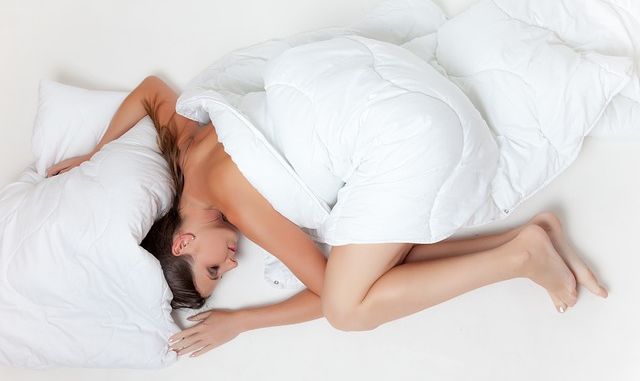
Never Underestimate The Importance Of Sleep
Sleep is essential for many bodily functions including stabilizing blood glucose levels, blood sugar drop that promotes awakening and sugar regulatory hormones. Millions of Americans suffer from insomnia at some point in their life, turning, twisting and agonizing all through the night battling rumpled covers and unnecessary anxiety.
Insomnia its self can be attributed to physiological and physical conditions as the stress of the day may be keeping individuals from sleeping well. Health can be affected in as little as three days if natural sleep patterns are interrupted, sleep deprivation, blood sugar levels rise and hormone imbalances occur all resulting in weight gain. The disease can develop over time, heart disease, diabetes, obesity, stress, anxiety, depression, hypoglycemia, overeating, vitamin B deficiency, asthma, drug addictions to nicotine or other drugs, and toxic liver overload of high levels of copper in the liver.
Common causes of insomnia are due to the inability to turn of thought patterns that may be considered stressful keeping individuals awake at night all leading to health complications. Too much caffeine during the day can defiantly keep you awake. The good news is there are caffeine free beverages tea, coffee that should not interfere with natural patterns if consumed moderately.
Insomnia Causes Health Risks
- Weight Gain, Obesity
- Hypoglycemia
- Depression
- Anxiety
- Sleep Deprivation
- Vitamin B deficiency
- Heart disease
- Diabetes
- Hormone Imbalance
- Drug Addictions
Learn proven strategies that you can implement to fall asleep and get a good night rest every day of the week. Understanding sleep patterns that naturally occurring a state of mind categorized by altered consciousness and the inhibition of all voluntary muscle movements, relatively inhibition of sensory activity and reduced interactions with surroundings.
Physiology of Sleep – How Do We Fall Asleep?
Sleep occurs in repeated patterns in which the body alternates between non-REM a highly distinct mode and REM pattern in which the eyes are closed and moving involuntary called ” rapid eye movement” that also involves other aspects virtual paralysis of the body during this phase. It is disqualified by wakefulness by decreased ability to react to stimuli but is easily reversed compared to being comatose.
Sleep is divided into two broad types nonrapid eye movement (NREM) or non (REM sleep) and rapid eye movement (REM) both have a distinct set of neurological and physiology features. REM sleep is associated with dreaming, desynchronized and faster brain waves, loss of muscle tone.
Important bodily functions in an anabolic state occur to repair while sleeping including building the immune system, muscular system, skeletal, and nervous system. In the last century, natural patterns have drastically changed due to diet and exposure to artificial light sources from computers, iPhones, cell phones have altered sleep patterns and timing of the internal clock.
Research has shown that sleep has beneficial effects on the body by assisting the elimination of waste products in the brain, improving overall health and relaxing the mind. The mechanisms and diverse purposes of sleep are subject to ongoing research.
The dream state is a well-known feature of natural patterns and is considered an important aspect of wellbeing an experience recounted as a narrative form as walking life in progress. A dream state is a peak into the unconscious mind and although we rarely remember our nighttime reveries they hold the key to consciousness.
Dreams are vivid sensorimotor experiences with structure while sleeping. We experience them consciously seeing, hearing within our environments that appear, completely real although we do not smell during the dream state nor are we passive observers we love, speak, fight and resolve issues all within the dream state of mind. Remember dreams by keeping a tablet and pen by the bedside. Record any dreams you may have during the night to reveal thoughts that may be keeping you up at night.
Disorders Caused by Insomnia Have Serious Side Effects
Insomnia a disorder known as sleeplessness whereas individuals have difficulty sleeping. They may have trouble falling asleep or staying asleep as long as desired. Insomnia is usually followed by daytime sleepiness, decreases energy, depressed mood, irritability and may contribute to memory, focus and learning impairment. Insomnia can last for just a few days, weeks or even months if left untreated.
Insomnia can occur independently due to physiological stressors or as a result of a physical condition, chronic pain, restless legs syndrome, heart failure, hyperthyroidism, menopause, heartburn and certain medications or drugs can contribute to insomnia including alcohol, caffeine, and nicotine use. Other risk factors include sleep apnea and working at night as this causes the bodies natural sleep rhythms to fall out of balance.
Diagnosis is based on a full physical examination and complete study of patterns to find underlying causes of insomnia. Screening may be done by asking two important questions, ” Do you have difficulty sleeping or ?” and “Do you have difficulty falling or staying asleep?”
Treatment for insomnia is usually sleeping hygiene or lifestyle changes that will have a definite impact on health. Starting with a consistent bedtime ritual, regular exercise, sunlight exposure during the day, regular exercise and a clean dark room for sleeping. Designate one room for rest and relaxation away from distractions, pets, artificial light, noise and interruptions to maximize complete rest. Studies show that a clean well-organized room with good ventilation is optimal for sleep.
While sleeping pills may help they are also associated with injuries, dementia, and drug addictions. Medications are not recommended for more than 4 to 5 weeks as the effectiveness and safety is unclear with prolonged use.
Primal Sleep– Discover the trick to getting a good nights sleep by fighting insomnia at the root cause. Lets you sleep through the night and wake up feeling refreshed rested and ready to start your day.
Binaural beats send different sound frequencies to each ear through headphones. The difference is to send one frequency to the right ear and a different frequency to the left ear makes the frequencies we want to train the brain to also known as the “Frequencies Response Process” Binaural beats auto designed to aid sleep and cure insomnia, entertains the brain using Theta low frequencies and mild Delta frequencies. Theta frequencies prepare the brain for falling asleep zone while the Delta frequencies evoke a state of deep sleep.

Sleep apnea Disorder Interrupts Natural Breathing
Shallow breathing during sleep is usually caused by sleep apnea a condition that pauses breathing while an individual tries to rest. Each pause can last for a few seconds to a few minutes each night and may occur several times during the night. The most common form of this condition may be a snoring or choking sound as breathing resumes. This can result in disrupted sleep, drowsiness, and fatigue during the day. Children may experience hyperactivity and learning complications in school as a result.
There are three forms of sleep apnea called central (CSA) and obstructive (OSA) and the combination of the two called mixed. Obstructive (OSA) is the most common form and is clearly related to obesity or weight gain, Risk factors include a family history of this disorder, allergy symptoms, enlarged tonsils and even being overweight can contribute to (OSA). In (OSA) natural breathing patterns are interrupted blockage of air flow, while in (CSA) breathing stops due to a lack of effort to breath leaving an individual with oxygen deprivation and fatigue.
People with this disorder are not always aware they have it until a family member. Usually, a diagnosis is made during an overweight sleep study in which more than five episodes of interrupted breathing must occur an hour.
Treatment for this disorder includes lifestyle changes, weight loss, diet, mouthpieces, breathing equipment and possibly surgery. Other changes may include sleeping on one side, stop smoking, avoid alcohol and any other drugs that may cause serious side effects. Talk to your doctor about any medicines you are taking.
Without proper treatment sleep apnea may cause certain risk factors including stroke, heart attack, diabetes, heart failure, irregular heartbeat and injuries associated with sleep disorders. Equipment used as breathing devices called CPAP machine is worn while sleeping and assists in the normal breathing patterns giving the user more oxygen waking up feeling refreshed.
Research shows that individuals who are suffering from obstructive (OSA) or central (CSA) or a combination of both may benefit from using CPAP machine for a period of time. Some users were able to lose weight and return to natural breathing patterns without the use of equipment.
Other sleep disorders include dyssomnias, parasomnias, hypersomnia, narcolepsy, parasomnias, sleepwalking, circadian rhythm, REM a behavioural disorder, and bruxism. See your family physician if you are having difficulty sleeping or staying asleep for a full evaluation and recommendations.

Tips For Sleeping Well
- Eat light meals at dinner around 5:00 PM for good digestion
- Have a dark well-ventilated room for sleeping
- Schedule bedtime at the same time each night
- Wake up at the same time each day
- Get 6-8 hours of good solid sleep each night
- Avoid sugary, salty, or foods high in saturated fats, alcohol, drugs are known to interfere with sleep, nicotine, caffeine
- Lose weight
- Find a good diet plan that you can eliminate in your daily routine
- Walk once per day for 30-60 minutes
- Relax by finding activities you enjoy doing
- Avoid artificial light from computer, iPads, iPhones before bed- as the light interfrears with sleep
- Eat protein one hour before bed 25 almonds or 2 tablespoons of almond butter or peanut butter
Food Therapy for Insomnia or Chronic Inability To Sleep
Simple lifestyle changes can make a huge difference in the ability to fall asleep and stay asleep. Eating only light meals at dinner and avoiding saturated fats will not only help reduce weight but help with rest.
Late night snacks low in calories packed with protein help stabilize sugar levels during the night. Eat 25 roasted almonds one hour before bed or two tablespoons of peanut butter or two tablespoons of almond butter, or other options include celery, celery juice, wheat germ or one tablespoon wheat germ oil, 1/2 cup brown rice, 1 cup warm milk, lemon water and one teaspoon honey, or brewers yeast found online or at your local health food store.
Have a glass of pure mineral water as the minerals aid in digestion and relaxation. Avoid heavy meals at dinner, alcohol, sugary, salty and fatty foods as these take the body longer to digest and may prevent sleep.
Effective tea chamomile, Siberian ginseng, St. John’s wart, catnip, lemon balm, Rishi Mushroom/ ginseng, licorice have been shown to establish good sleep patterns. It may take a few days of common sense therapy to finally get the rest you deserve. Find snakes and teas that help you stay asleep for longer periods of time, wake up feeling refreshed and invigorated.
Body Work For Inducing Complete Rest and Relaxation
Exercising in the morning outdoors to absorb sunlight and breath in fresh air is the optimal time for physical activity if you can. Walking once per day 30- 60 minutes will have a huge impact on health and sleep patterns as prostaglandins are released helping you sleep in 12 hours later. If you are not able to exercise in the morning stick to a schedule that works best for you as a regular fitness program can reduce weight and improve overall health.
Yoga Burn for weight loss or relaxation is a fantastic way to unwind, build muscle and tone your entire body. Find classes at your local gym, CD’s or online at YouTube. Find a yoga routine that fits your specific needs and level. Get step by step instruction from fitness instructors Jillian Michales Yoga Melt Down for Beginners, Yoga for Weight Loss for beginners by Cortney at Physic Truth or Yoga with Denise Austin. Gain strength and stability with a 30 to 60-minute Yoga Burn workout.
Leave me a comment and share this post with friends.
Cheers!
Patricia Lynn
Images Courtesy of DietRobins, Luxstorm, PlubicDomainPictures at Pixbay.com